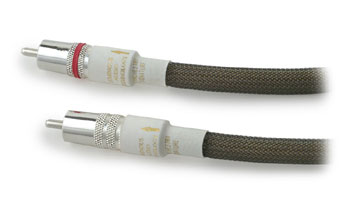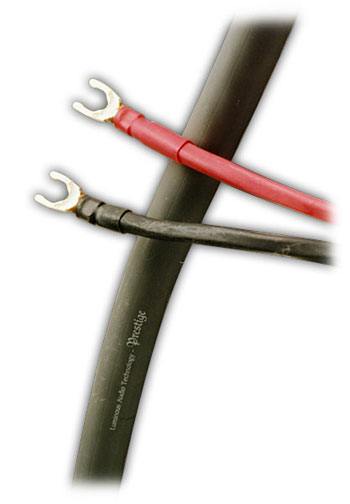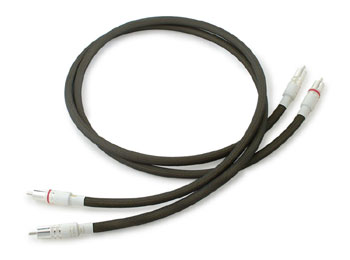You are reading the older HTML site
Positive Feedback ISSUE
11january/february 2004
luminous audio
Synchestra Signature interconnects and Prestige speaker cables
as reviewed by Art Shapiro

ART SHAPIRO'S SYSTEM LOUDSPEAKERS ELECTRONICS SOURCE CABLES ACCESSORIES
|
There are two schools of thought with respect to audio components—the dogmatic and the pragmatic viewpoint. Actually there’s a third viewpoint, often associated with speaker cables and interconnects, which we might term the stannous aurum (tin-eared engineer) category. You all know this type of person, the audiophile equivalent of a Pod Person. He asserts that all cables sound alike, and that anyone who thinks otherwise is sadly delusional and is trying to justify an utterly worthless yet expensive purchase. He then starts babbling phrases such as "double blind test" and "snake oil." You want to take one of the fifty-cent, generic patch cables that came with this person’s mass market receiver, and wrap it around… but I digress.
The dogmatic audiophile asserts that there is precisely one absolute, and that the goal of an audio system is to precisely reproduce what the recording engineer engrained on the CD, LP, or other medium. Any departure from that absolute, even if it enhances the musical experience, is by definition a defect. It’s a legitimate philosophy, although it has been my experience that systems conforming to this ideal can be sterile and devoid of emotion, revealing a lot of detail but sacrificing musicality. The dogmatists will no doubt disagree with my assessment. I respect their position, but do not think it the audio ideal.
The pragmatists—the group in which I place myself—believe that the goal of an audio system is to reproduce music in an aesthetically rewarding manner. If that differs from the sound that the engineer heard when creating the recording, so be it. After all, the same musician or musicians playing the same piece on separate days might have a slightly different interpretation and a different sound due to the sonic differences between concert halls, the effects of a large vs. small audience, a Baldwin piano in one hall vs. a Steinway in another, etc., etc., etc. Why can’t our audio systems have a similar range of presentation and still be considered legitimate?
What does this babbling mean? I’ve long asserted that there is some finite range of sounds along the dry-to-warm spectrum that is reasonable and acceptable. It is possible that the sonic characteristics described by audiophiles, such as the aforementioned dry/warm, fast/slow, and detailed/blurred dichotomies, actually represent slight differences in tonal balance. In any event, there is some gradation of sonic presentation that strikes me as acceptable. Go too far in one direction and the sound gets excessively revealing and detailed. Go over the edge in the other direction—such as with some older tube amplifiers—and you start to lose so much detail that music becomes a meaningless mass (although this kind of system can be utterly mesmerizing with some music).
Enter the Luminous cables. I’ve been a fan of this small company’s products for more than ten years, back when they were far less in the audio consciousness than today. I purchased three pairs of the company’s original Monarch interconnects on the recommendation of a very well heeled audiophile who described them as one of the true bargains in audio. He was right—they were marvelous performers, though admittedly my system was less significant than the one I have today. I later purchased a length of the original Synchestra cable, which was a step up from the Monarchs. I still use the Monarchs in some of the less critical links in my system, but rarely use the Synchestra because the system is hostile toward silver cabling. I know that the metal employed shouldn’t have much to do with the acceptability of a given wire, but every silver interconnect or speaker cable that I’ve recently tried makes the sound too lean.
When Mr. Luminous, Tim Stinson, offered some of his cables for review, I was eager to see what his recent creations would do in my system. I was in the process of switching from my single Music Reference RM9 II amplifier to a pair of Manley Neo 250 monoblocks. These amps are too large for my rack, requiring both floor placement and longer interconnects than the one-meter ones I’d previously used. Conversely, shorter speaker cables would be preferred. I warned Tim that silver was a no-no in this system. He sent a six-foot shotgunned bi-wire pair of Prestige speaker cables. This is the company’s low-end speaker cable. Tim stated that the higher-level speaker cables in the line had already received several reviews, and that he was anxious to get an assessment of the entry-level product in a high end system. He also sent a one-meter and a two-meter length of Synchestra Signature interconnects. This is a fairly pricey model, well up in the product line.
As for my own cable choices, I’ve used a bi-wire pair of Cardas Golden Hexlink 5C speaker cable for several years, and have been quite happy with it. All critical interconnects have been Monster’s penultimate cable, the M-Sigma 2000. When the Manleys arrived, I did a lot of experimentation using my own and borrowed cables, propping up the amps on a workstand in order to make use of the many different one-meter interconnects I had at my disposal. The Sigma 2000 continued to be the product of choice in this system. Unfortunately, it is no longer in the product line, and the folks at Monster couldn’t come up with a two-meter pair for me, though they did provide their top-of-the-line Sigma Retro interconnects. These are much warmer cables than the Sigma 2000, and they pushed the system to just about the limits of acceptability in the dry-to-warm spectrum. The formidable Cardas/Monster combination was thus a tough challenge for the Luminous products—they were going up against carefully chosen cabling that had proven its superiority against numerous competitive products.
I lived with the Luminous cables for a few months, quite a bit longer than originally expected. This wasn’t because of desperate attempts to ascertain and articulate subtleties and nuances, or to struggle to discern small differences between the Luminous and my existing cables. It was simply because I loved what they did! As the weeks passed, it was a pleasure to just enjoy the manner in which they portrayed music. The speaker cables and interconnects have a similar tonal balance, and work extraordinarily well together. My tenure with these products was a pleasure, but eventually Tim Stinson started to want some prose, and I guess that’s fair.

Let’s consider some specifics, beginning with the Prestige speaker cable. The reality is that the Prestige was bested by my Cardas cable. As I went back and forth between the two (unfortunately, an awkward process taking a good five minutes), I consistently used the adjective "raw" to describe the Luminous product. There was less harmonic subtlety and ambience with this speaker cable, and the presentation was somewhat more forceful. But—and this is a huge but—consider the price points of the two cables. This is Luminous’ low end product, costing something like five bucks a foot (okay, I bi-wire, so double that), while the Cardas costs some ridiculous multiple of that. It oughta be better! I can’t tell you how many times I thought to myself, "Given the price discrepancy between these two cables, I can’t believe how well the Luminous cable is doing." There was a little more bloom and harmonic richness with the more expensive cable, but if anyone’s going to condemn the Prestige for that, it isn’t going to be me.
An example is a marvelous recital disc I’ve often cited, a Swedish Society CD (SCD 1049) entitled Solveigs Sang, with soprano Soveig Faringer and pianist Nanette Nowels-Stenholm in a group of Scandinavian songs. I frequently listen to the title track, a piece by Grieg. The gorgeous resonance of the soprano voice was slightly tamed with the Luminous cable, although scarcely to a degree that I would term excessive or intrusive. I similarly experienced just a bit less bloom and harmonic subtlety with the accompanying piano. The presentation was totally within the bounds of good taste, but slightly more down to earth than with my reference cable.
The tonal balance between the two cables differed slightly, with the Cardas having a tad more bass weightiness, befitting its reputation as a warm product. The Luminous had slightly more treble weight, which at times could enhance the clarity of musical presentation without being excessively detailed. In some of the jaw-dropping pianistic pyrotechnics throughout the Sony CD entitled Earl Wild, The Romantic Master, I could hear a little bit more into the individual notes through the slightly drier Luminous product, even if the Cardas could sing a touch more. I appreciated the bloom, air, subtlety, and richness of my existing cable while realizing that the Luminous had much to offer in revealing the inner complexities of the music.
The macro-dynamic capacity of the Prestige cable was impressive. At times, given the same volume setting on my CAT preamp, the music seemed a bit louder in the louder sections with this cable. This, I repeat, is from the company’s least expensive speaker cable. Bang for the buck? The Prestige has it in spades. Physically sturdy and attractive, with obviously high-quality spade lugs, this product is well worth your consideration if you’re dabbling in this part of the price spectrum. By audiophile standards, it’s a bargain.

On we go to the Synchestra Signature interconnects, most decidedly not an entry-level product. This product was, like the speaker cables, attractive and solid looking, with heavy RCA plugs. Documentation warned that the plug/wire interface was somewhat fragile, and urged that the cables be attached and detached by the RCA plugs, not by handling the wire itself. I treated them with respect and had no problems. The tonality of the Synchestra Signature was similar to that of the speaker cable—slightly less bass-emphatic than my existing cables, a little cleaner, and slightly less rich. It struck me as a quite neutral product, neither excessively warm nor sterile. I was very impressed with the tonal balance of my system when the Synchestras were in place. It moved noticeably away from the warm side into a quite admirable presentation.
I spent a lot of time with Earl Wild, The Romantic Master, possibly my favorite CD. Musically enjoyable and with stellar sonics, the tracks of this CD encompass the gamut of pianistic techniques and sounds, making it a superb auditioning vehicle. Track 2 of this CD is Mr. Wild’s own variations on Handel’s "The Harmonious Blacksmith." My Monster interconnects gave a rich, warm presentation, with the impression of being a bit slower than the Luminous. The piano image struck me as more compact and focused with the Monsters. Through the Luminous, a very even tonal balance was apparent, and there was the sensation of improved speed. Although very fast, I never felt that the sonics became lightweight. The sound seemed more spread out across the room. My cables gave me more sonic impact on the low end of the keyboard, as befits a warm cable, but the faster runs and figurations were more distinct on the Luminous cables. This probably represents the antithesis of warmth, and similarly there was a touch less harmonic subtlety, though hardly to a degree I’d consider a drawback.
I played another track of this CD, the Papst Paraphrase on (Tchaikovsky’s) Sleeping Beauty, an utterly jaw-dropping pianistic tour de force. The forceful, direct nature of the Luminous gave exceptional sonic impact on the savage midrange complexities that open this work, and the treble seemed louder and more prominent. The melodic clarity of the piece’s profusion of notes was enhanced by the less warm (but most assuredly not dry) Synchestras. Proving that you can’t have it both ways, the emphasis on the midrange melodic structure meant that the silvery treble figurations were slightly less obvious and captivating. The rapid upper-keyboard figurations were a tad more down to earth, but cleaner and doubtlessly more accurate. I could readily appreciate what both interconnects were doing, as both portrayed music in an enjoyable manner.
I then turned to a large scale orchestral CD on Chandos containing music of Sir Edward Elgar, including the Enigma Variations and the six Pomp and Circumstance marches. I concentrated on the fourth Pomp and Circumstance, not the famous one we all hear at graduations. The orchestral presentation was more forward on the Luminous, with a clearer, less resonant melodic framework that enhanced my ability to hear into the music. I was somewhat surprised to find the bass drum more tonal through the Luminous, and the crescendos somewhat louder. The clear sonic perspective of the Luminous gave a very powerful presentation. I consistently appreciated what it was doing for orchestral works.
To assess the performance on vocal works, I again pulled out the Solveigs Sang CD. As might be expected, my Monster interconnects gave a somewhat more subtle presentation due to the harmonic richness of both the soprano voice and the piano. The Luminous was clearer, and in one spot I noticed a mechanical noise coming from the piano, something I’d never noticed in the hundreds of times I’ve played this track. Afterwards, being keyed into its existence, I could notice it with my own cabling.
Turning to one of my few non-classical CDs, I pulled out Bela Fleck’s Flight of the Cosmic Hippo. There were no surprises here. The Luminous was more direct and forceful, providing excellent clarity with slightly diminished harmonic richness on the electric guitar. I was more conscious of the melodic flow through the Luminous. On the title track, my own interconnects were more subtle, perhaps more harmonically interesting. The Luminous gave more impact in the lowest "hippo" strains, which is not what I expected.
I thought the Luminous cable was a terrific performer in my system. I could easily live with it. It is slightly more forward and direct than my existing cabling, and relatively neutral without being dry. The tonal balance is admirable, the imaging spacious without being diffuse, and the clarity first rate. A little bit of harmonic subtlety is sacrificed due to this clarity, but the result is totally within the bounds of good taste. It was with more than a trace of sadness that I boxed up the cables and sent them on their way to Luminous Audio. If you can play in this financial ballpark, the Synchestra Signatures are highly recommended for your consideration. Art Shapiro
Prestige speaker cables
Retail: $4.99 a foot ($40 for termination)
Synchestra Signature interconnects
Retail: $399 a meter pair
Luminous Audio Technology
web address: www.luminousaudio.com
